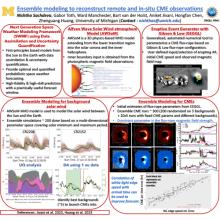Ensemble modeling to reconstruct remote and in-situ CME observations
Nishtha
Sachdeva
University of Michigan
Poster
Accurate space weather impact predictions require high-fidelity and high-skill modeling of solar transients like Coronal Mass Ejections (CMEs)
The Space Weather Modeling Framework (SWMF) includes MHD modeling of the solar wind and CMEs from the Sun to the Earth and beyond. The Alfven Wave Solar atmosphere Model (AWSoM) is a 3D extended-MHD solar corona model within SWMF that reproduces the solar wind background into which CMEs can propagate. The Eruptive Event Generator (EEG) module within SWMF is used to obtain flux-rope parameters to model realistic CMEs within AWSoM using different flux-rope configurations.
It is important to improve the models and tools using uncertainty quantification and data assimilation techniques to reconstruct CMEs. This is done by validating simulation results with multi-viewpoint observations of the solar corona and the inner heliosphere at various heliospheric distances.
In this work supported by the NSF SWQU and LRAC programs, we perform an ensemble of solar wind background simulations to obtain the best plasma environments into which CMEs can be propagated. We vary the flux-rope parameters to do an ensemble of CME simulations and compare the model reconstructed results with remote coronagraph observations near the Sun (LASCO C2/C3 and STEREO COR1/COR2) as well as with in-situ observations of solar wind plasma at 1 au. The ensemble modeling is a step forward towards improving the accuracy of the tools that provide flux-rope parameter estimates as well as quantifying the uncertainty in CME modeling.
The Space Weather Modeling Framework (SWMF) includes MHD modeling of the solar wind and CMEs from the Sun to the Earth and beyond. The Alfven Wave Solar atmosphere Model (AWSoM) is a 3D extended-MHD solar corona model within SWMF that reproduces the solar wind background into which CMEs can propagate. The Eruptive Event Generator (EEG) module within SWMF is used to obtain flux-rope parameters to model realistic CMEs within AWSoM using different flux-rope configurations.
It is important to improve the models and tools using uncertainty quantification and data assimilation techniques to reconstruct CMEs. This is done by validating simulation results with multi-viewpoint observations of the solar corona and the inner heliosphere at various heliospheric distances.
In this work supported by the NSF SWQU and LRAC programs, we perform an ensemble of solar wind background simulations to obtain the best plasma environments into which CMEs can be propagated. We vary the flux-rope parameters to do an ensemble of CME simulations and compare the model reconstructed results with remote coronagraph observations near the Sun (LASCO C2/C3 and STEREO COR1/COR2) as well as with in-situ observations of solar wind plasma at 1 au. The ensemble modeling is a step forward towards improving the accuracy of the tools that provide flux-rope parameter estimates as well as quantifying the uncertainty in CME modeling.

Poster PDF
Poster category
Solar and Interplanetary Research and Applications
Meeting homepage